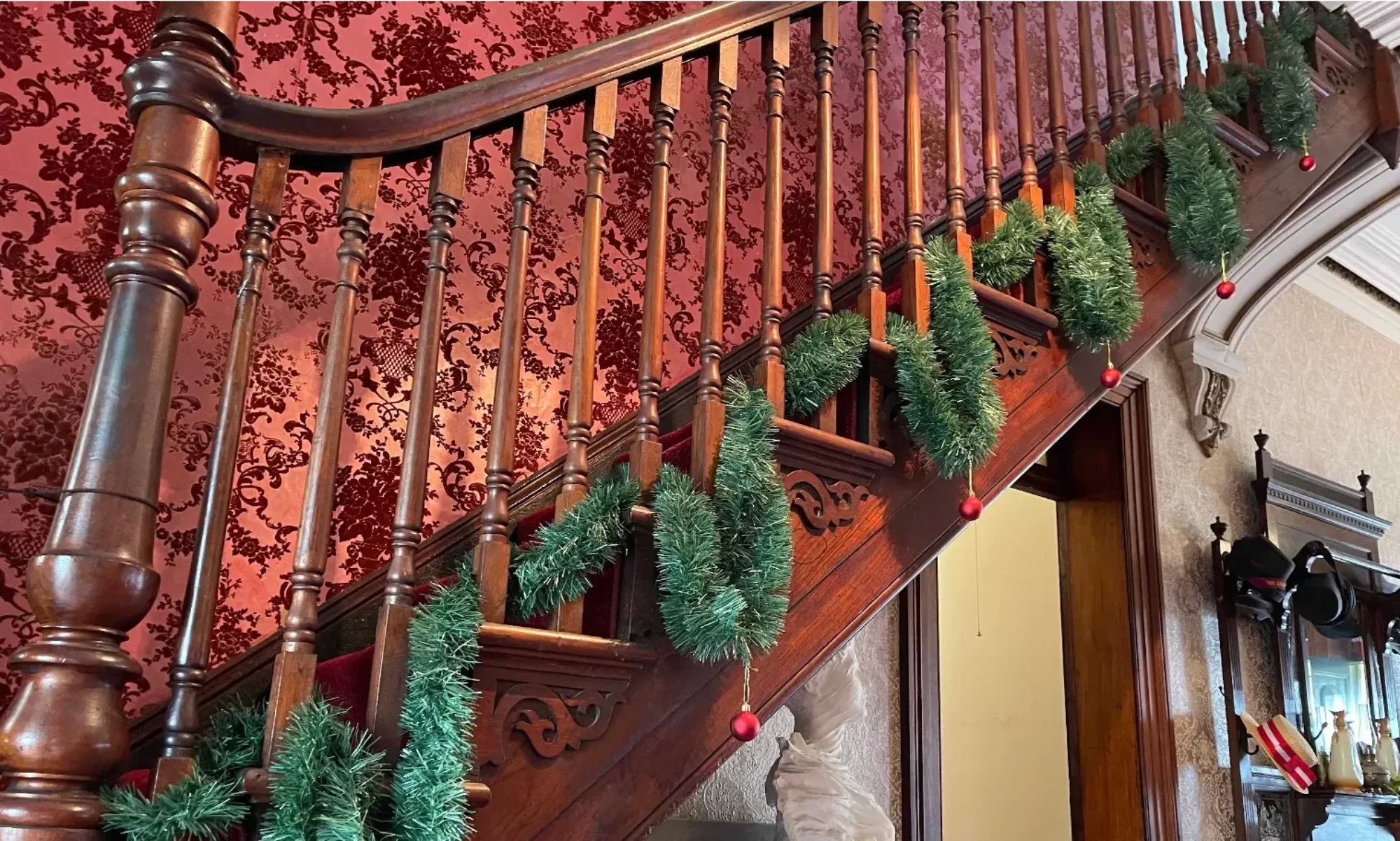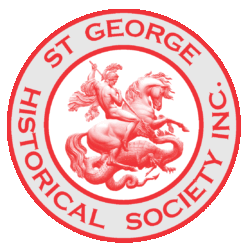By Anne Carolan
The name Gannon is familiar even to newer residents of the St Peters/Tempe area because it features as the name of a street. Long-time residents still call the now dilapidated old home in Union Street, ‘Gannon’s Place’. Those interested in local history will know that the road to Hurstvile was once called ‘Gannon’s Forest Road’ and that Hurstville itself was known as ‘Gannon’s Forest’ until a century ago. There are also a number of older residents who can just remember the kindly old man with a neat white beard pottering about the garden he loved at ‘Hurlingham’, the family home. Beyond the home were Gannon’s paddocks, the Sts Peter and Paul’s Catholic Church in Station Street (1858) and the family vault. One resident remembers his job collecting milk money which included calling at ‘Hurlingham’ from Unwin’s Bridge Road. On one occasion he was grateful to old Mr Gannon who found and returned 10/- which he had lost – a small fortune in the 1920s.

The Gannon who, in 1850, bought 1903 acres of the Townson grant and, at a toll gate charged the wood gatherers of Sydney Town to enter his forest, was Michael Gannon – convict, carpenter/builder, innkeeper and land speculator. Frederick Gannon Snr., solicitor, of ‘Hurlingham’, Union Street, Tempe, who died, aged 87, on 10 October 1923 was the fifth of Michael Gannon’s seven sons.
The family of Michael and Mary Gannon included: John b. 30.4.1825 (m. Eliza Laurance or Lawrence); Mary b. 29.4.1827 (d. infancy); Robert b. 22.6.1829 (m. Agnes Conley); William b. 13.8.1831 (m. 1 Rose Edmunds or Edwards; 2. Helena Parry; James b. 11.12.1833 (m . Jane Chadburn); Fred erick b. 21.3.1836 (m . Clarissa Rebecca Murray); Joseph b. 5.7.1838 (m. Susanah Jane Andrews); Alfred b. 21.6.1840 (m. Elizabeth Hunt) ; Alicia b. 21.6.1842 (m. W.H.D. Mitchell) ; Maria b. 6.8.1845 (in. C.H. Linehan).
Michael Gannon, who was transported from Ireland under a life sentence, arrived with his brother James in Sydney on the ‘Almorah’ in 1820. In 1824 Michael married Mary Parsonage acquiring as his in-laws Thomas Parsonage (‘Hillsborough’, 1798) and Mary Jones (‘Earl Cornwallis’, 1801). The Gannon brothers came as convicts but appear to have established themselves and stable homes through marriage. Michael Gannon also rapidly established himself in business as a builder and auctioneer in Cambridge and Argyle streets, Sydney.
Next time you visit the Rocks, glance over the back wall of 45 Argyle Street and imagine little Fred Gannon running about the garden with his brothers 145 years ago. For Michael Gannon, the builder, had moved his family into this gentlemen’s residence around 1839. It can be assumed that he was skilled at his trade as the house still stands, protected by the Sydney Cove Development Authority which states that ‘this house contains more original joinery than any other building in the period in the Rocks. For example, the 200 mm. floorboards are unique to the Rocks and are a rare commodity in historic buildings generally.’
Frederick Gannon was about seven years old when the family moved to Cook’s River around 1842. They lived on Cook’s River Read (now Prince’s Highway) before he moved to ‘Hurlingham’ in the 1870s. Frederick was educated at Sydney College and was admitted as a solicitor in 1864. In 1861 Frederick married Clarissa Rebecca Murray, daughter of Robert Murray of the Farrier’s Arms, George Street, Sydney and ‘Yarrum’, Lyons Road, Fivedock. Her mother was Rebecca Miller or Bennett and now Frederick, too, had in-laws with convict origins dating from the very early years of the colony. Robert Murray had a half – brother, Thomas Smidmore – a family also well known in Marrickville and surrounding areas.

The family of Frederick Gannon Snr. included: Clara b. 4.5.1861 (m. William Edward Carter); Edith b. 2.6.1862 (d. infancy); Frederick S. b. 4.2.1864 (m. Elizabeth Toomey); Les lie b. 24.11.1865 (m . Kathleen Marie Sexton); Ada b. 23.5.1867 (m . Charles McDonell) ; Walter b. 23.11.1868 (m. Patience Longfield); Arthur b. 6.1.1871 (m . Lottie Farr) ; Archibald b. 16.6.1872 (m . Nellie Jones ); Percy b . 28.10 .1873 ; Stanley b. 16.7.1875 (m. Ethel Raynor); Claude b. 30.12.1876 (m. Elsie Dibley); Henry b. 10.4.1879.
Such was the pace of social change that Frederick Gannon, a convict’s son, was able to model his Hurlingham Estate at Tempe upon the exclusive Hurlingham Sporting Club of London which is still in existence. Tempe, then, was considered an attractive area with grand homes dotting the hills. Holt’s ‘Warren’ and Spark’s ‘Tempe’ were two of these. ‘Burlingham’, too, was on a hill with splendid views down to the river and out to Botany Heads. It had its own pigeon shoot and became a centre of music, sport and entertainment. In its prime it was graciously furnished and decorated. As time went by some of the rooms became lined with sporting trophies. For Frederick Snr. loved all sport – he was a noted athlete in his youth and was a cricketer on the old Albert Ground when ‘it was not considered playing the game to bowl overhand’. He was a member of the Australian Jockey Club and, even in his last years, his sons were expected to row him about Botany Bay to his favourite fishing haunts.
The third public golf course established in Sydney was at Marrickville. It came into being on 20 September 1897 on land donated by Fred. Gannon who remained its Patron for many years. The links were close to the station at Tempe and the P.G.A. Monthly of May 1952 stated that ‘some of the hazards , notably a cliff on the banks of the Cook’s River, were of a decidedly sporting character . . .the face of the Cliff Hole was somewhere between 30 and 40 feet high. If a player failed to get height with his iron shot he often found the ball back behind a tee from which he hit. Another unusual hole was at the back of a hotel. If a player pushed his shot out he had to play his second over the back fence of the hotel to get to the green. Some inebriated gentlemen must have sobered up smartly when a ‘screamer’ sailed over their heads! ‘
Frederick Gannon Snr. sent six of his sons to Newington College and later two joined him in the firm, Fred. Gannon & Sons , said to be the largest criminal law practice in the city at the time. Gannon practised law until the age of 85 by which time he was the oldest solicitor on the roll. Following in his father’s footsteps, Frederick continued to buy and sell land in the area. He acquired ‘Tempe House’ in 1884, something his father had failed to achieve when he bid for his neighbour Brodie Spark’s property on 27 December 1853. Within a year ‘Tempe House’ and its grounds had been sold to the Sisters of the Good Samaritan.
Clarissa Gannon died, aged 85, on 12 November 1922, 11 months before her husband. They were buried at South Head Cemetery. Subsequently ‘Hurlingham’ and its remaining grounds were auctioned. Some members of the Gannon family still reside in and around the Marrickville area. Clare Gannon B.A., a granddaughter of Frederick , taught for many years at St George Girls’ High School before retirement. Michael Gannon was my great-great-grandfather; Fred. Gannon Snr. was my great-grandfather; Leslie Ernest Gannon was my grandfather; Biela Gannon, who grew up in ‘Hurlingham’ was my mother. I would be please to hear from any other descendants of the Gannons of Tempe who would like to share their reminiscences.
This article was first published in the January 2013 edition of our magazine.
Browse the magazine archive.


I attended school at St Mary’s Starbof the SeabHurstville to 4th class in 1950 then to Marist kogarah till 1955 there was a Mick(Michael} Gannon in my class who I think lived in Carlton- I wonder whether he is part of the original Michael Gannon family?